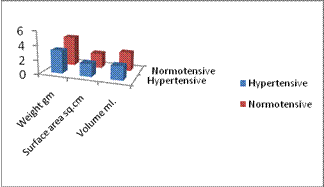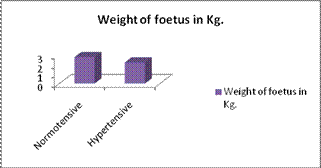 |
|||||||||||||||||||||||||||||||||
|
|
|||||||||||||||||||||||||||||||||
 |
|||||||||||||||||||||||||||||||||
|
|
[Abstract] [PDF] [HTML] [Linked References]
S. P. Ghodke*, N. V. Kale** *Assistant Professor, **Professor, Department of Anatomy, Dr. D.Y. Patil Medical College, Kolhapur, Maharashtra, INDIA. *Corresponding Address: Research Article
Abstract: Placenta is a fascinating organ especially when its function is considered. Placenta reflects the changes due to maternal hypertension as it’s a mirror of maternal and foetal status. The study of hundred placentas is done to find out the morbid changes in placenta of hypertensive mothers in comparison to those of mothers with normal pregnancies. In gross appearance the placenta of mothers of PIH (Pregnancy Induced Hypertension) were smaller, irregular .Weight, Surface area and volume showed reduction in placenta of PIH mothers. Also calcified areas seen showing signs of insufficiency. Severity of hypertension adversely affects both foetal and placental outcome. If PIH is diagnosed early stage by frequent monitoring of blood pressure, clinical examination and urine examination added precaution can be taken during antenatal period and labour to reduce further risk. Keywords: Pregnancy induced hypertension, Placenta, Surface area of placenta, Weight of foetus, Weight of placenta.
Introduction Now a day, in the life of stress & strain, increased maternal age, change in the life style of Indian women, cases of pregnancy induced hypertension are going on increasing. As an Anatomist it is very much essential to know Morph metric changes in the placenta of hypertensive women in relation to normal. From last century most of the work has been done with the placenta, mainly by the Obstetrician and Gynecologist. Very little work is contributed by Anatomist. Thomsan (1969) [1] and Younoszai and Howorth (1969) [2] studied that placental weight and size are directly proportional to the birth weight. Dutta (1989) [3] reported reduction in placental weight in hypertensive disorders of pregnancy. Das (1996) [4] focused on low birth weight, low apgar score and still births in hypertensive disorders in pregnancy. Till 1996 nobody has taken efforts to measure the exact surface area of placenta in pregnancy induced hypertension. Virupaxi (2003) [5] did co-relation of placental weight, volume and decidual surface area in relation to low birth weight babies and normal babies. Toxaemia of pregnancy is the leading cause of maternal mortality and is an important factor in foetal loss. The incidence is high in backward countries with malnutrition, hypoprotinemia and poor obstetric facilities. Placenta is a unique wonderful organ that arises denovo, directly related to growth and development of foetus in utero. The present study is done at D.Y. Patil medical college in Anatomy and Obstetric Department. Cases were selected from South Maharashtra. Age of Mother was between 20 to 35 years. Control cases were normotensive and pregnancy induced hypertensive mothers had B.P.140/90 mm of Hg or above. In present study comparison between the morph metric changes in placenta of normal pregnancy and pregnancy induced hypertensive mothers was done. The study is also touching to come for conclusion about the volume of placenta of above mentioned cases and to arrive at regression equation in regards to (1) Weight of Placenta, (2) Volume of Placenta, (3) Exact surface area of placenta.
Material and Method Weighing Machine for placenta (2 K.G.), Baby weighing Machine (10K.G.), Measuring Jar, Scalpel with surgical blade, Graph paper, Blotting paper, 100 placenta. From south Maharashtra 100 placenta of mothers ranged from 20 to 35 years were studied. 50 were from normotensive and 50 from hypertensive mothers B.P. > 140/90 mm/Hg. Placentae were prepared by washing, cord cutting and blotting excess of water. The amnion and chorion were trimmed from placenta. Measurements included weight, surface area and volume of placenta at 34 to 40 weeks of gestation. Most of the placentas were from primipara. The weight of placenta was measured in grams with the help of weighing machine. Volume of placenta was calculated by using Archimedes principle. Method used for volume was easy. A big jar with broad mouth was taken. It was kept in tray. Jar was fully filled with tap water. Placenta was immersed in jar slowly by holding it to umbilical cord. Volume of displaced water was measured by measuring glass. Baby weight was recorded in each case to study effect of hypertension. The surface area of placenta was calculated by taking imprint first on card sheet and then on graph paper.
Observation and Results 100 placenta of mothers ranged from 20 to 35 years were studied. 50 were from normotensive and 50 from hypertensive mothers B.P. > 140/90 mm/Hg. Birth weight of babies in normotensive mothers and hypertensive mothers was recorded. Mean foetal weight in normotensive mother--- 2.81 Kg. Mean foetal weight in Hypertensive mother--- 2.24 Kg.
Table 1: Placental mean weight in gms, Placental mean surface area in cm2, Placental mean volume in ml. mentioned in column no.1.In column no. 2 Control N==50 is mentioned. In column no. 3 Hypertensive disorder N==50 is mentioned. Macroscopic Findings of Placenta
Statistical significance that is P<0.01 is significant for all 3 parameters
Discussion Hypertensive disorders have definite adverse influence on morphometry of placenta. Placenta provides valuable information in foetal outcome. Pregnancy induced hypertensive syndrome exerts its deleterious effects on the placenta .The present study was under taken to analyse and to asses morph metric variations of placenta like weight, surface area & volume. A hypertensive disorder of pregnancy is a disease of primigravida as reported by Teasdale [6]. Salvatore [7] reported preterm deliveries in 50.71 % of the hypertensive cases. Our study cases were monitored in health camp and in regular OPD. We found fewer incidences of premature & low birth weight babies. Dasgupta H. Mujumdar [8] reported that hypertensive placenta tends to be smaller than the normotensive. Nazmeen [9] also reported weight and volume of placenta to be less in pregnancy induced hypertension cases. Chakarvorty [10] studied the foetal and placental weight changes in normal and preeclampsia, he supported the same. Compared to Mujumdar [8] in our study Placental mean weight & volume recorded is less because of regional effects & due to more number of primipara in our study. Virupaxi[5] noted reduced Placental weight and its ratio to birth weight in normal pregnancy .Method used for calculating volume is very easy which can be easily performed by Dai’s in PHC which will be helpful to detect reduced placental volume & in turn reduced foetal weight.
Conclusion In this study we come to a conclusion that maternal hypertensive disorders have definite adverse influence on morphometry of placenta. It also showed that placenta have great potential to provide valuable information in cases of adverse foetal outcome. In these days of increasing medico legal cases, this will help a lot many doctors to achieve the goal of good foeto-maternal outcome.
Acknowledgement I gratitude towards Mr. Sanjay D. Patil, Chancellor, Dr. H. S. Pawar, Vice-chancellor of, D. Y. Patil University for their continuous encouragement. I am Thankful to Dr. R. N. Kadam, Dean and Dr. Mrs. Ashalata Patil, Professor and Head of the Department Anatomy. D. Y. Patil Medical College, Kolhapur for allowed me to undertake the present study. I take this opportunity to express my sincere thanks towards my guide Dr. Naina Kale, Associate Professor of Anatomy. Without whose continuous encouragement, kind and critical analytic guidance this work could not have been completed. I am very grateful to Dr. Shashikant Kulkarni Professor and Head of the Department of Obstetrics and Gynecology. Of Dr. D. Y. Patil Medical college, Kolhapur. For providing necessary placenta of delivered patients from their department. I am also indebted to all my departmental colleagues for assisting me in completing this work. By regular monitoring and supervision in pregnancy induced hypertensive cases will result in GOOD FOETAL WEIGHT AND INREASED INCIDENCE OF NORMAL DELIVERY.
References
|
||||||||||||||||||||||||||||||||
|
|||||||||||||||||||||||||||||||||



